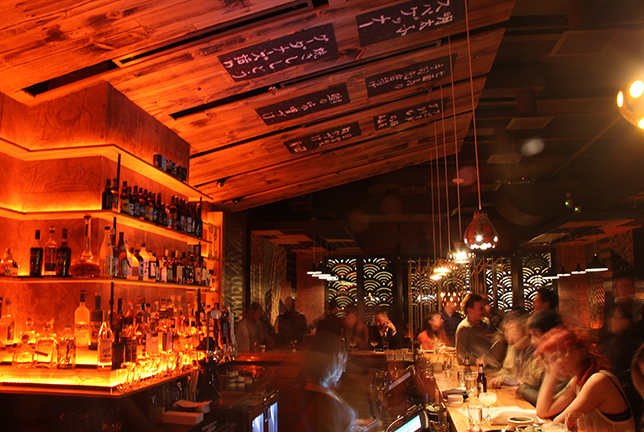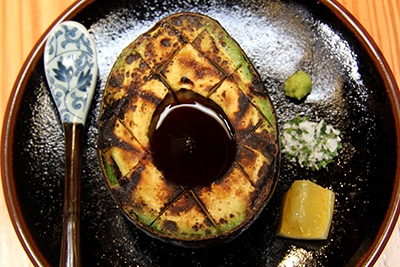
Small-plate restaurants and craft-cocktail bars are ubiquitous across major cities in the United States. They’re called different things — dim sum, gastropubs, tapas, mezzes, cicchetti — but the meaning is the same. The latest trend in small-plate dining is the Japanese izakaya (ee-ZAH-ka-ya), which translates to “a sit-down sake shop.” In Japan, these small pubs often specialize in one particular kind of food — chicken or even horse meat — but in America, it generally just means small portions of a variety of Japanese favorites, and perhaps even sushi or sashimi. But unlike other small-plate spots, izakayas are more than just a dining destination — they’re a drinking culture with a foodie bent.
Before you delve palate first into this culinary endeavor, know your terminology. Try okonomiyaki, often called “Japanese pizza,” a pancake topped with veggies and meats or seafood, mayonnaise and tonkatsu sauce. Sushi lovers will enjoy onigiri, rice balls stuffed with fish, pickled plum, kombu and mentaiko (spicy cod roe). Less adventurous eaters will want to opt for yakitori (grilled chicken skewers) or kushiyaki (grilled meat or veggie skewers) and agedashi tofu (tofu deep fried in broth).
Dishes come out in progression as they are ready, and more substantial plates — anything involving rice and noodles — are saved for the end of the meal. Since izakayas are as much about drinking as they are about food, these heavier dishes are used to soak up all the alcohol you’ve consumed throughout the dining experience and to help prevent a headache the next day. Now that you know the background, try these five great izakayas across the United States:
PABU, Baltimore
Located within the Forbes Travel Guide Four-Star Four Seasons Hotel Baltimore and the brainchild of acclaimed chefs and restaurateurs Michael Mina and Ken Tominaga, PABU offers enough in the way of big-name attraction to woo nearly any type of diner. You’ll find everyone from suited businessmen to well-dressed 20-somethings snacking on sushi and sashimi flown in daily from Japan or meats prepared on a massive traditional robata grill. Try the Berkshire pork belly served with Japanese pepper and sake — it’s delicious. The modern space, all light woods and sweeping curves of steel, overlooks the city’s famed Inner Harbor from floor-to-ceiling glass windows. While the restaurant’s signature drink list is strong, we suggest heading to the 10-seat sake bar and sampling a flight of one of the more than 100 varieties from Tiffany Dawn Soto, the hotel’s beverage manager. She’s one of the few master sake sommeliers in the country — and one of the best-known female sake experts in the world.
 Daikaya, Washington, D.C.
Daikaya, Washington, D.C.
You’ll never look at a cup of noodles the same way again after a meal at Daikaya, Washington, D.C.’s popular izakaya. Hatched up by three Japanese chef-partners, the restaurant is a small taste of Japan in Washington’s Chinatown, offering a stacked approach seen in many high-density areas of Tokyo. It’s easy to spot from the street at night, as the restaurant’s backlit exterior resembles a Japanese lantern. Ramen 1F, on the restaurant’s first floor, offers Sapporo-style ramen, a favorite variety that includes a rich and hearty miso-based broth topped with vegetables and meat. Upstairs, the Izakaya 2F specializes in comfort food with a modern twist. Don’t miss the wasabi octopus, seasoned with wasabi sprouts, green apple and olive oil, or the sesame panna cotta, a not-too-sweet ending to the meal. And remember — izakayas aren’t just for nighttime. Daikaya also offers a sought-after weekend brunch.
Aburiya Raku, Las Vegas
Ask any Las Vegas chef worth his salt where he goes to eat after hours and he won’t name a place on the Strip, but rather a strip mall. Located 10 minutes from the north end of Las Vegas Boulevard sits Raku, nestled inelegantly in the heart of Chinatown. Technically dubbed an aburiya (a slightly more upscale version of an izakaya known for serving tavern food), Raku makes up for in quality what it lacks in décor. The 48-seat restaurant is simply designed in dark woods. The look is no frills, but the food — from the first bite of the housemade agedashi tofu to the udon noodle with foie gras egg custard soup — is divine. It’s no surprise, given that chef Mitsuo Endo trained first as a formal kaiseki-style chef. Try the $100 or $150 multi-course tasting menu, available only on request.
Izakaya Den, Denver
The founders of Denver’s popular Sushi Den on historic South Pearl Street opened this 250-seat izakaya next door, offering a mix of traditional Japanese dishes with international flavors. Mexican, French and Italian ingredients play a part in the menu’s robust array of options. The restaurant flies in more than 2,000 pounds of fish daily from Japan to form an extensive and fresh sushi listing, while popular dishes like the den short ribs in Korean marinade with jalapeños, haricots verts and mushrooms round out the heartier plates. Just be sure to slow your sake consumption — the altitude in the city will likely give you a mile-high headache if you overindulge.
Blue Ribbon Sushi Izakaya, New York City
The newest of the Blue Apron brand of restaurants, eponymously named Blue Ribbon Sushi Izakaya, draws loyal fans to its home on the second floor of the Thompson LES hotel. As trendy as the location suggests, the menu pays homage not only to Blue Ribbon’s superior reputation for sushi — the fresh daily specials are always a good bet — but also to more conventional pub fare. Come with a crowd to the New York City hot spot, all the better to see and be seen. Then order the kushiyaki skewers of perfectly grilled and seasoned meat, the ideal complement to oshinko (pickled vegetables), or even the less traditional but no less beloved Blue Ribbon signature — fried chicken. Wash it all down with the house Blue Ribbon junmai ginjo sake. The restaurant is also open for breakfast and lunch daily.
Photos Courtesy of Brian Liu and Toolbox D C

